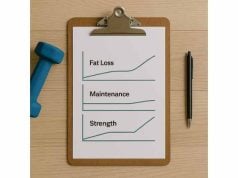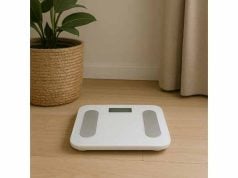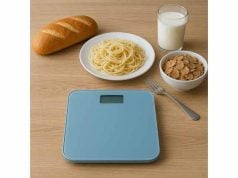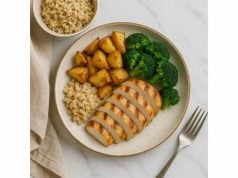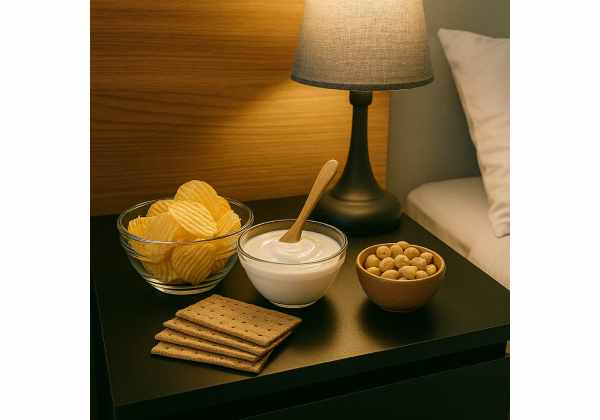
You tighten your meals all day, then the evening arrives: appetite swells, willpower thins, and the scale refuses to budge. Late-night snacking can erase an otherwise solid calorie deficit and create a frustrating, “I’m doing everything right” plateau. This guide shows exactly why that happens and what to change—without white-knuckling your nights. We’ll map the patterns that keep you stuck, rebuild your evening routine, and give you durable fixes you can live with. If you want a broader diagnostic beyond night eating, see our concise plateau troubleshooting guide for cross-checks you can run in a few days.
Table of Contents
- How late-night snacking stalls fat loss
- Find the plateau pattern
- What drives evening hunger
- Build a sane night plan
- Calorie and macro tweaks at night
- Break habit loops, not willpower
- When to pause or raise calories
- FAQ
How late-night snacking stalls fat loss
A plateau is rarely a mystery: energy balance governs body weight. Most people target a modest daily deficit—often 300–500 calories. Late-night snacking quietly closes that gap. A “small” bowl of cereal, a couple of cheese slices, or a handful of nuts can add 150–300 calories each. Two quick grabs and your day’s deficit disappears.
Evening is vulnerable for three reasons:
- Decision fatigue and reward seeking. After a full day of choices, your brain defaults to convenient, high-reward foods. These are energy-dense and easy to over-eat while distracted.
- Under-fueling earlier. Skipping breakfast, tiny lunches, or low-protein days drive up evening hunger. Your appetite system is not fooled by daytime restraint; it collects at night.
- Environment and cues. Light, screens, open packages, and “treat” routines (dessert during a show) become automatic prompts. You may not feel “hungry” so much as “this is what I do now.”
The math is blunt. An extra 200 calories at night wipes out roughly 0.4 lb (0.18 kg) of weekly fat loss you expected from a 400-calorie deficit. Bump that to 300–400 calories (snack + drink), and the scale may trend flat or inch upward despite clean daytime eating.
Does timing itself matter? Timing can influence hunger, training, and sleep, but total intake rules. That said, late eating often couples with lower satiety (liquid calories, simple carbs without protein), less tracking, and less movement afterward—making it easier to overshoot. Alcohol magnifies this: it adds calories, lowers restraint, and pairs with salty snacks.
What helps is not “never eat after 7 p.m.” but structuring the evening so your plan survives real life. You can keep a snack and still progress if the total budget works and the choice is filling. The first fix is rebuilding the earlier part of your day and the way you set up your nights. If you need a refresher on pacing a sustainable deficit, skim our clear primer on safe weight-loss basics before you change your evenings.
Key takeaway: Night eating isn’t a character flaw; it’s the predictable result of low daytime structure meeting high evening cues. Control the inputs, and the plateau cracks.
Find the plateau pattern
Before you overhaul dinner, confirm you’re in a real stall and pinpoint where evenings run long. Think of this as a short audit, not a diet sentence.
Step 1 — Confirm the plateau.
Use a daily morning weigh-in after bathroom, before food, minimal clothes. Track 14 days, then compare the first 7-day average to the second 7-day average. If the difference is under ~0.25–0.5% of body weight, you’re likely plateaued. If the trend is down but the day-to-day bounces hide it, you may be fine.
Step 2 — Tag the evenings.
For the same 14 days, add two quick notes each night:
- Hunger (0–10) at 8–10 p.m.
- What and how much you actually ate after dinner (estimate if needed).
Do not chase exact grams; relative patterns beat precision here. Circle any nights that blew past plan.
Step 3 — Identify triggers.
Scan your notes. What clusters with high-calorie nights?
- Under-eating earlier: lunches < 400 calories, protein < 25 g, or long gaps without food.
- Stress or conflict: meetings, late emails, tough commutes.
- Context: TV + couch + open packages; phone + scrolling; kitchen light on; kids’ snacks visible.
- Alcohol: even one drink can combine with 200–400 “accidental” snack calories.
Step 4 — Check tracking blind spots.
Night extras often go unlogged: oils, dressings, “finishing bites,” beverages. Add a one-week honesty check where you log before eating at night. You’re not changing intake yet—just creating visibility.
Step 5 — Define success.
Pick a clear target: three nights per week with ≤ 200 planned snack calories or zero unplanned eating. Ambiguous goals (“be better”) don’t beat habit loops.
If you’re unsure whether you’re truly stuck, run the quick tests in our two-to-four-week plateau check. It shows how to separate a true stall from normal water and glycogen noise so you don’t fix what isn’t broken.
What you’ll learn: Most plateaus trace to repeated evening calorie drift on predictable days (stress days, long workdays, late workouts, social nights). That’s good news: predictable means fixable.
What drives evening hunger
Evening hunger is not only “weak will.” Several levers make nights feel harder than mornings.
1) Sleep debt and circadian pressure.
Short sleep raises appetite signals and dulls satisfaction. When tired, your brain prefers fast-reward foods, and restraint drops. Going to bed an hour earlier can reduce evening snacking simply by shrinking the window and improving appetite control the next day. If this is you, see our recovery-focused guide on sleep and fat loss.
2) Protein and fiber distribution.
Total daily protein matters, but so does timing. Long gaps without protein set up late cravings. Aim for 25–40 g protein at each meal and 8–12 g fiber to sustain fullness into the evening. If lunch is mostly carbs and fat, dinner won’t “catch up” satiety before snack o’clock hits.
3) Thirst and sodium swings.
Mild dehydration (common after afternoon coffee and little water) and salty meals drive both thirst and “snacky” urges. A big glass of water or herbal tea before you open the pantry can cut impulse nibbles.
4) Emotion and reward.
Food is a reliable soother. If you use it to transition from “work me” to “home me,” your brain learns that cue. That doesn’t make you broken; it makes you human. The fix is building alternative transitions that deliver a similar exhale (brief walk, shower, lights dimmed, 10 minutes of low-effort tidying with music).
5) Late training or long days.
Evening workouts can spike hunger—especially if carbs are too low earlier. Likewise, long unscheduled days lead to grazing at night. Both problems respond to planned fuel: a late-afternoon protein + fiber snack (e.g., Greek yogurt with berries) and a decent carb portion with dinner.
6) Alcohol and permissive talk.
“I was good all day.” That sentence may precede the highest-calorie choices of your week. Add a drink, and the “why not” switch flips. Keep a one-drink rule or swap to a no-alcohol beverage on weeknights.
Quick self-test: If your evening hunger falls noticeably on days you:
- sleep 7–8 hours,
- hit 30 g protein at lunch, and
- drink 1 liter of water after 3 p.m.,
your issue is likely physiology and structure, not discipline. Solve those first; willpower comes last.
Build a sane night plan
You do not need a curfew to lose fat; you need pre-decided options that are easy, satisfying, and boring to overeat. Here’s a plan that survives real evenings.
1) Pre-decide the lane (Green / Yellow / Red).
- Green (no snack): You’re not hungry; dinner was satisfying. Close the kitchen; make tea; go to bed on time.
- Yellow (planned snack ≤ 200 calories): You want something. Choose one template below. Log first.
- Red (hungry and restless): Eat a mini-meal (250–350 calories) with 20–30 g protein. Then close the night.
2) Use snack templates that actually fill you up.
Pick one and stick with it for a week:
- Greek yogurt (170 g) + berries (100 g) + cinnamon.
- Cottage cheese (200 g) + tomato + pepper + drizzle of balsamic.
- Casein shake (1 scoop) blended with ice + 1 tsp cocoa.
- Whole-grain toast + 2 eggs or egg whites + salsa.
- Air-popped popcorn (30 g kernels) + nutritional yeast.
- Apple + 2 tsp peanut butter (not a heaping spoon from the jar).
3) Create friction on everything else.
Keep tempting foods out of sight and unopened. Store sweets in opaque containers, high shelves, or outside the living room. Keep “green lane” items front-row in the fridge.
4) Replace the transition.
Decide your new evening ritual: 10-minute walk or stretch, shower, change lighting, herbal tea. Anchor it to the moment you usually open the pantry.
5) Pre-log to slow the hand.
At 7–8 p.m., log what you will eat if hunger appears. If you’re not tracking, write it on a sticky note. The simple act of deciding once cools impulsive choices.
6) Protect sleep.
Set an electronics off alarm and get to bed 30–60 minutes earlier. If you’re awake less, you snack less. Satiety hormones work better when you’re rested.
For more fullness strategies that raise protein and fiber without blowing calories, browse our simple playbook on high-volume eating. It pairs perfectly with the night plan above.
Bottom line: Nights become easier when structure, visibility, and friction align. Keep choices narrow and repeatable; variety can return later.
Calorie and macro tweaks at night
Sometimes the fix is not “eat less at night” but shift what and when you eat so the same daily calories keep you satisfied.
Distribute protein evenly.
Target 0.7–1.0 g/kg/day split across meals with 25–40 g per sitting. If dinner is your smallest protein meal, bump it by 10–20 g (fish, lean beef, tofu, seitan). Even distribution improves fullness and can reduce late cravings.
Move some carbs to dinner.
If you train late or crash after work, shift 20–40 g of carbs from the afternoon to dinner (potatoes, rice, whole-grain pasta, legumes). Pair with vegetables and protein to slow digestion.
Use a pre-bed protein option.
A casein-rich snack (cottage cheese or casein shake) digests slowly and can reduce nocturnal hunger without many calories.
Budget on purpose.
If you enjoy a night snack, plan it: allocate 150–250 calories from earlier meals. You’re not “cheating;” you’re budgeting. People who plan snacks tend to nibble less overall than people who forbid them.
Rebalance the day if hunger persists.
- Add 100–150 calories to dinner from protein + veg + starch.
- Remove 100–150 calories from an afternoon snack or add a small lunch.
- If fatigue and gym performance are falling, consider a refeed day or raise baseline calories slightly.
If you need help with the numbers, use our walkthrough on how to adjust calories and macros when loss stalls. It shows safe increments and what to monitor over 2–3 weeks.
Rule of thumb: Keep the nightly plan consistent for 10–14 days before judging. Appetite adapts; your data will too.
Break habit loops, not willpower
Night eating often follows a reliable loop: Cue → Craving → Response → Reward. You will win more often by editing the cue and response than by demanding more willpower at 9:30 p.m.
Map the loop.
Write one sentence: “When I [cue], I usually [response] to feel [reward].” Example: “When I open Netflix, I usually eat cereal to feel calm.” Naming the loop makes it malleable.
Install an “if-then” plan.
Decide a replacement response that delivers a similar reward with lower calories.
- If I open Netflix, then I make tea and portion my popcorn in a bowl.
- If I feel tense after emails, then I do a 5-minute reset walk before entering the kitchen.
Increase friction on the old response.
- Store treat foods in the garage or a high cupboard.
- Keep only single-serve portions at home.
- Use smaller bowls; keep containers off the coffee table.
Shrink the window.
Pick a kitchen closed time. Set a phone reminder. If you’re still hungry at that time, choose one pre-approved mini-meal, eat it at the table, and stop.
Make the reward visible.
Track streaks of “planned nights completed.” A calendar with real marks beats vague intentions.
If weekends unravel your good week, align your night plan with our simple fixes for weekend overeating. Most people need slightly higher planned calories or a social script, not more rules.
Remember: You are not fighting hunger alone; you’re redesigning the path of least resistance. Make the good choice easiest and the old choice inconvenient.
When to pause or raise calories
Sometimes the right move is not to push harder at night—it’s to change the phase. Prolonged deficits can amplify evening hunger, poor sleep, and food preoccupation. Here’s when to pause or raise calories:
Choose a 10–14 day diet break (at estimated maintenance) if you notice three or more:
- Persistent irritability or rumination about food.
- Waking at night hungry.
- Workouts and lifts trending down for 2+ weeks.
- Steps falling despite effort.
- Binge-like nights after otherwise “perfect” days.
How to run it:
- Calculate maintenance calories (your current weekly average intake + the rate you intended to lose × 500; or use a conservative calculator).
- Keep protein high (≥ 1.6 g/kg/day).
- Maintain steps and training.
- Keep your evening structure—same snack templates, same kitchen closing time—so the break doesn’t morph into free-for-all.
When to raise baseline calories slightly (by 100–200/day):
- You’re within 5–10% of goal weight and hunger is disrupting sleep.
- Your loss pace is already slow (≤ 0.3%/week), yet hunger remains high.
- You’ve stacked several life stressors (travel, caregiving, heavy deadlines).
When to get professional help:
- Strong emotional eating that feels out of control.
- Possible disordered patterns (restriction–binge cycles).
- Medical concerns (medication changes, thyroid issues, perimenopausal symptoms) that complicate appetite and weight. A registered dietitian or clinician can help tailor the plan.
Bottom line: The bravest, most strategic choice is sometimes a phase change. Reset physiology, keep your evening system, then return to a gentle deficit.
FAQ
Is late-night snacking always bad for fat loss?
Not necessarily. What matters most is total daily intake. If you plan a small, high-protein snack within your calorie budget, you can still lose fat. Problems arise when evening eating is unplanned, energy-dense, and layered with alcohol, screens, and low awareness.
How many calories can a nightly snack have during a cut?
Keep planned night snacks to 150–250 calories with 15–30 g protein. If you’re truly hungry, use a mini-meal at 250–350 calories with protein and fiber rather than grazing. Consistency beats perfection; pick one option and repeat it for a week.
What should I eat at night to stay full?
Choose protein-forward options with some fiber: Greek yogurt with berries, cottage cheese and tomato, a casein shake, eggs on whole-grain toast, or air-popped popcorn. Avoid calorie-dense, low-satiety foods like nuts straight from the bag, cereal, and sweets in open bowls.
Does eating before bed slow metabolism?
No. Timing doesn’t “shut off” metabolism. Late eating can harm progress when it adds unplanned calories or disrupts sleep. A small, protein-rich snack can be neutral or helpful if it prevents larger binges and fits your overall daily calorie budget.
How do I stop mindless snacking at night?
Edit the cue and environment. Pre-log a planned option, portion it, and keep tempting foods out of reach. Add a short transition ritual, such as a walk or shower. Close the kitchen at a set time. Track streaks of evenings completed as planned for visible momentum.
Can I save calories for dinner and still lose weight?
Yes. Many people prefer larger dinners. Shift calories by trimming earlier meals, but keep protein evenly distributed (25–40 g per meal). Pair dinner carbs with vegetables and lean protein. Planned budgeting works; unplanned grazing after dinner is what derails progress.
References
- Calorie Restriction with or without Time-Restricted Eating in Weight Loss 2022 (RCT)
- Effects of Experimental Sleep Restriction on Energy Intake, Energy Expenditure, and Visceral Obesity 2022 (RCT)
- Pre-sleep Protein Supplementation Affects Energy Metabolism and Appetite in Sedentary Healthy Adults 2022 (RCT)
- Protein Distribution and Muscle-Related Outcomes: Does the Evidence Support the Concept? 2020 (Review)
- Calorie reformulation: a systematic review and meta-analysis examining the effect of manipulating food energy density on daily energy intake 2022 (Systematic Review)
Disclaimer
This article provides general education about nutrition and behavior change. It is not medical advice and does not replace personalized guidance from a qualified clinician or registered dietitian. If you have a medical condition, take medications affecting appetite or weight, or notice disordered eating patterns, seek professional care.
Share and follow
If this guide helped, consider sharing it with a friend who struggles with night snacking. For more practical updates, follow us on the social platform you use most—Facebook, X (formerly Twitter), or another network you prefer.


